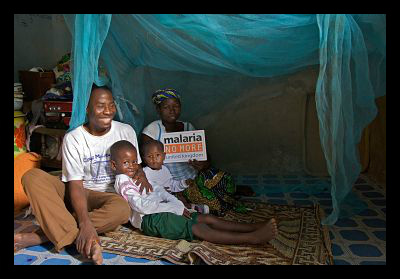
Every 60 seconds, a child dies from a preventable and curable disease that claims the lives of 453,000 children per year—90 percent of those in Africa.
Malaria is considered one of the top three causes of death for children worldwide. But there’s one nonprofit that’s taking on the challenge to slow down the clock and lower its global threat to about half the world at risk. Malaria No More is dedicated to bringing an end to malaria deaths by engaging leaders, rallying the public and delivering lifesaving tools and education to families across Africa.
With the rate of 13,000 children losing their lives to a mosquito bite everyday, it is a critical time for this nonprofit to do its work efficiently and effectively. They do this through two sectors: lifesaving commodities and health education.
Malaria No More has covered over five million people with mosquito nets in at least 17 African countries, which to date is the surest way to prevent malaria. In Senegal, the organization conducted the first universal coverage of mosquito net distribution. In Cameroon, they inspired over 500,000 people to sleep under mosquito nets with their education campaign.
In the Fall of 2013, Malaria No More launched a campaign to deploy rapid diagnostic tests and artemisinin-based combination treatments to reduce malaria deaths in children. Rapid-diagnostic tests help expand the world’s ability to confirm malaria cases in remote settings and ensure that people get the right treatment where they need it. Likewise, artemisinin-based combination therapies act as a powerful treatment for malaria with a full course costing just one dollar to buy and deliver, curing a child one to three days time.
In addition to these lifesaving commodities, Malaria No More offers health education, which plays a vital role to preventing, diagnosing and treating the disease. For example, their NightWatch initiative has reached at least 20 million Africans by engaging mobile platforms and African leaders, from international music icons to local sports heroes, to deliver lifesaving health education.
Malaria No More works on the ground to make sure that every family in Africa has timely access to the resources they need, whether it’s providing mosquito nets to sleep under at night or the one dollar full-course treatment.
Other solutions the nonprofit suggests include indoor residual spraying to help kill mosquitoes and reduce the rate of malaria transmission in addition to the development of more vaccines for malaria and support via government funding.
Though foreign aid represents less than one percent of the U.S. federal budget, all efforts make an impact on the ground. Bridging the current funding gap and helping countries deliver lifesaving resources will help bring down the rate of malaria deaths. Since 2000, malaria mortality rates have fallen about 60 percent among children under the age of five, but there’s still much more work to do.
Thanks to technology behemoth Google, Malaria No More is closer to reaching their goals. In December 2014, Google made a huge move toward fighting against malaria by announcing a $600,000 grant to help fund a mobile phone project to combat the disease.
So how does it work? Since many Africans communicate via mobile phones, there’s no better way to collect data and send them vital information that details preventative measures that can save those in targeted areas from one of the most deadly diseases. Malaria No More will partner with a Nigerian startup called Sproxil, which helps fight the counterfeit drug market by putting codes on authentic medicines. Anyone who purchases these can now text the codes to verify the drugs.
In addition, texting codes allows Malaria No More to receive data on what drugs people are taking in remote areas as well as track the spread and treatments for the disease.
– Chelsee Yee
Sources: Malaria No More, Geek Wire, Fighting Malaria
Photo: Malaria No More

